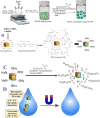Cooperative Molecular Interaction-Based Highly Efficient Capturing of Ultrashort- and Short-Chain Emerging Per- and Polyfluoroalkyl Substances Using Multifunctional Nanoadsorbents
- PMID: 39713664
- PMCID: PMC11656356
- DOI: 10.1021/acsomega.4c07159
Cooperative Molecular Interaction-Based Highly Efficient Capturing of Ultrashort- and Short-Chain Emerging Per- and Polyfluoroalkyl Substances Using Multifunctional Nanoadsorbents
Abstract
The short-chain (C4 to C7) and ultrashort-chain (C3 to C2) per- and polyfluoroalkyl substances (PFAS) are bioaccumulative, carcinogenic to humans, and harder to remove using current technologies, which are often detected in drinking and environmental water samples. Herein, we report the development of nonafluorobutanesulfonyl (NFBS) and polyethylene-imine (PEI)-conjugated Fe3O4 magnetic nanoparticle-based magnetic nanoadsorbents and demonstrated that the novel adsorbent has the capability for highly efficient removal of six different short- and ultrashort-chain PFAS from drinking and environmental water samples. Reported experimental data indicates that by capitalizing the cooperative hydrophobic, fluorophilic, and electrostatic interaction processes, NFBS-PEI-conjugated magnetic nanoadsorbents can remove ∼100% short-chain perfluorobutanesulfonic acid within 30 min from the water sample with a maximum absorption capacity q m of ∼234 mg g-1. Furthermore, to show how cooperative interactions are necessary for effective capturing of ultrashort and short PFAS, a comparative study has been performed using PEI-attached magnetic nanoadsorbents without NFBS and acid-functionalized magnetic nanoadsorbents without PEI and NFBS. Reported data show that the ultrashort-chain perfluoropropanesulfonic acid capture efficiency is the highest for the NFBS-PEI-attached nanoadsorbent (q m ∼ 187 mg g-1) in comparison to the PEI-attached nanoadsorbent (q m ∼ 119 mg g-1) or carboxylic acid-attached nanoadsorbent (q m ∼ 52 mg g-1). In addition, the role of cooperative molecular interactions in highly efficient removal of ultrashort-chain PFAS has been analyzed in detail. Moreover, reported data demonstrate that nanoadsorbents can be used for effective removal of short-chain PFAS (<92%) and ultrashort-chain PFAS (<70%) simultaneously from reservoir, lake, tape, and river water samples within 30 min, which shows the potential of nanoadsorbents for real-life PFAS remediation.
© 2024 The Authors. Published by American Chemical Society.
Conflict of interest statement
The authors declare no competing financial interest.
Figures





Similar articles
-
2D Fluorinated Graphene Oxide (FGO)-Polyethyleneimine (PEI) Based 3D Porous Nanoplatform for Effective Removal of Forever Toxic Chemicals, Pharmaceutical Toxins, and Waterborne Pathogens from Environmental Water Samples.ACS Omega. 2023 Nov 13;8(47):44942-44954. doi: 10.1021/acsomega.3c06360. eCollection 2023 Nov 28. ACS Omega. 2023. PMID: 38046318 Free PMC article.
-
Imparting Selective Fluorophilic Interactions in Redox Copolymers for the Electrochemically Mediated Capture of Short-Chain Perfluoroalkyl Substances.J Am Chem Soc. 2023 May 3;145(17):9508-9519. doi: 10.1021/jacs.2c10963. Epub 2023 Mar 21. J Am Chem Soc. 2023. PMID: 36944079
-
Simultaneous analysis of perfluoroalkyl and polyfluoroalkyl substances including ultrashort-chain C2 and C3 compounds in rain and river water samples by ultra performance convergence chromatography.J Chromatogr A. 2017 Nov 3;1522:78-85. doi: 10.1016/j.chroma.2017.09.049. Epub 2017 Sep 23. J Chromatogr A. 2017. PMID: 28965989
-
Physicochemical properties and interactions of perfluoroalkyl substances (PFAS) - Challenges and opportunities in sensing and remediation.Sci Total Environ. 2023 Dec 20;905:166764. doi: 10.1016/j.scitotenv.2023.166764. Epub 2023 Sep 1. Sci Total Environ. 2023. PMID: 37660805 Review.
-
Progress on the removal of PFAS contamination in water by different forms of iron-modified biochar.Chemosphere. 2024 Dec;369:143844. doi: 10.1016/j.chemosphere.2024.143844. Epub 2024 Dec 2. Chemosphere. 2024. PMID: 39612997 Review.
Cited by
-
Magnetically Retrievable Nanoparticles with Tailored Surface Ligands for Investigating the Interaction and Removal of Water-Soluble PFASs in Natural Water Matrices.Sensors (Basel). 2025 Jul 11;25(14):4353. doi: 10.3390/s25144353. Sensors (Basel). 2025. PMID: 40732485 Free PMC article.
-
Insight into the Photocatalytic Degradation Mechanism for "Forever Chemicals" PFNA by Reduced Graphene Oxide/WO3 Nanoflower Heterostructures.ACS Omega. 2025 Mar 4;10(10):10675-10684. doi: 10.1021/acsomega.5c00054. eCollection 2025 Mar 18. ACS Omega. 2025. PMID: 40124034 Free PMC article.
References
-
- United States Environmental Protection Agency . Technical Fact Sheet: Drinking Water Health Advisories for Four PFAS (PFOA, PFOS, GenX Chemicals and PFBS). https://www.epa.gov/system/files/documents/2022-06/drinking-water-ha-pfa... (Accessed July 28, 2024).
-
- Neuwald I. J.; Hübner D.; Wiegand H. L.; Valkov V.; Borchers U.; Nödler K.; Scheurer M.; Hale S. E.; Arp H. P. H.; Zahn D. Ultra-Short-Chain PFASs in the Sources of German Drinking Water: Prevalent, Overlooked, Difficult to Remove, and Unregulated. Environ. Sci. Technol. 2022, 56 (10), 6380–6390. 10.1021/acs.est.1c07949. - DOI - PubMed
-
- Evich M. G.; Davis M. J. B.; McCord J. P.; Acrey B.; Awkerman J. A.; Knappe D. R. U.; Lindstrom A. B.; Speth T. F.; Tebes-Stevens C.; Strynar M. J.; Wang Z.; Weber E. J.; Henderson W. M.; Washington J. W. Per- and polyfluoroalkyl substances in the environment. Science 2022, 375, eabg906510.1126/science.abg9065. - DOI - PMC - PubMed
LinkOut - more resources
Full Text Sources
Miscellaneous
